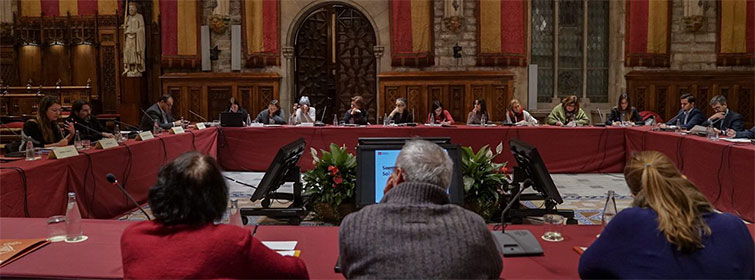- Home
- / Bodies Involved
- / Noise and Health working group
Noise and Health working group

The purpose of the 'Noise and Health in Barcelona' working group is to discuss noise in the city and its direct impact on the health of city residents, as well as contribute to solving the problems detected.
The city’s strategic noise map, now being updated, was drawn up in 2012 and shows that traffic is the main source of noise in the city, although the main source of public complaints is people concentrating in public spaces, which is often linked to evening and night-time leisure activities.
Current studies show that current noise levels have a direct and significant impact on the health of large segments of the population. Action therefore needs to be taken, by noise generators and receivers, to ensure the right to health. The overall perception of noise being a problem in the city is stable, but is very different depending on the neighbourhood. It is perceived as being a much bigger problem in neighbourhoods with lots of night-time leisure activities and that is where the most complaints are received from the public.
This is the context in which Barcelona City Council has set up the 'Noise and Health in Barcelona' working group to discuss noise in the city and its direct impact on the health of city residents, as well as contribute to solving the problems detected. The idea is to outline the situation, share what is being done and decide what more can be done, globally and across the board, by all those involved, in order to adopt measures and take specific action for each activity sector that can reduce noise levels in the city.
The working group first met on 19 December 2017 with Barcelona City Council represented by the Deputy Mayor for Ecology, Urban Planning and Mobility, Janet Sanz, the Commissioner for Ecology, Frederic Ximeno, and the Commissioner for Health, Gemma Tarafa, as well as social players linked to the political, economic and social area, mobility, the academic sector and professional associations, among others.
Sound Pollution Reduction Plan and Noise Map
Barcelona City Council has a Sound Pollution Reduction Plan, and a Noise Map, which follows the EU directive on assessing and managing environmental noise with the aim of outlining a common policy to combat noise. This year the Noise Map is being updated, which it will be every five years as stipulated in the current regulations, along with the new action plan for reducing noise pollution. The last one was drawn up in 2012 and the data obtained includes noise levels in different time bands and by sound source (traffic and leisure), the people exposed to different noise levels, comparative data with previous maps and so on.
The new map and the conclusions reached by the working group will enable the Measures Plan to be updated.
Traffic and night-time leisure are two factors that generate high levels of noise pollution in the city. Apart from the steps to reduce traffic envisaged in the new urban definition of the city, a series of actions are being implemented:
– Noise pollution controls and supervision network: 92 measuring devices placed in different public locations that measure noise levels continuously. These enable us to monitor noise levels in various city leisure areas, carry out mobility studies (vehicles, buses, trains, etc.), update the noise map, monitor implementation of the superblock scheme, evaluate activities that cause conflict and so on.
– Installing noise limiters at concerts in festivals organised by the City Council: at 2,166 concerts between 2015 and 2017.
– Carrying out acoustic characterisation studies in different places to find out the best location and distribution of concert stages, bar terraces and/or the acoustic feasibility of holding these types of activity in such spaces.
– Carrying out sonometric inspection of premises: 350 a year.
– Remote management of limiters installed in different city establishments open to the public, as well as sealing off TVs and Hi-Fi systems. Currently 577 activities are monitored and another 150-200 are added every year.
– Producing reports on acoustic conditioning projects, measures to check event sound levels, etc.: 2,407 reports between 2015 and 2017.
Public complaints are dealt with through the districts and around 1,500 annual inspections are carried out, while events planned for public spaces require the corresponding noise reports.
Apart from all this, the City Council also conducts awareness campaigns among the general public. It promotes the 'Sssplau' or 'Shhhplease' campaign, targeted at the public and schools as well. As an educational programme, it encourages Barcelona school students to be aware of and help to improve sustainable management of their surroundings by identifying problem spaces in schools with high noise indices: dining rooms, playgrounds, multipurpose rooms and gyms, for example, where action is required and measures need to be taken.
Sessions:
1st session: 19 December 2017
2nd session: 14 June 2018
